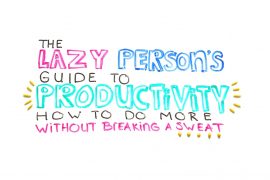When you hear the term ‘Cognitive Behavioral Therapy’ you probably think that it is not for you. That is for people who are dealing with mental health issues, right? Although this is true, the techniques used during cognitive behavioral therapy can help everyone.
Have you ever been afraid to ask for a raise or to give a presentation? Have you ever been dreading a certain social situation or have you avoided doing something because you believed you would fail?
While you may not be struggling with depression or anxiety, many of us do face mental challenges. Almost everyone has experienced feelings of depression, fear, unworthiness and more. And at some point, everyone has experienced so-called cognitive distortions like overgeneralization, jumping to conclusions, catastrophizing or emotional reasoning. Although this is all very common and completely normal, it can stand in the way of us feeling good and living the best life we can.
What the heck is Cognitive Behavioral Therapy anyway?
In short, Cognitive Behavioral Therapy (or CBT) aims to improve mental health by changing thoughts and behaviors that are underlying the problem someone is dealing with. Cognitive Behavioral Therapy is built on the idea that EMOTIONS, THOUGHTS and ACTIONS are all interconnected. It’s a very practical ‘problem solving’ approach.
You see? Therapy is not so scary!
Now, let’s put this into practice
Let’s say you are terrified of public speaking.
You think nobody cares about what you will have to say. (THOUGHTS!)
You do whatever it takes to avoid having to speak in front of an audience, big or small. (ACTIONS!)
You feel bad about this because you know you are missing out on career opportunities due to this. (EMOTIONS!)
Your overall mental image regarding public speaking is now negative and makes you feel pretty bad about yourself.
Step 1: Find the reason for your problem
A reason could be that you experience the cognitive distortion of ‘personalization’. You believe that it is a personal reaction to you when people play with their phone, yawn or look out the window while you are speaking. You conclude that they do this because they don’t care about what you are saying. This thought causes you to feel unworthy and awkward. Do you see how thoughts are influencing emotions here?
Your coping strategy is to avoid the situation. But because of this behavior you feel even worse: a vicious cycle.
Step 2: Check your thoughts
Your ‘core belief’ in this situation seems to be that people don’t care about what you have to say. But, is this belief true?
In order to change destructive thoughts you need to test their validity. You need to develop ‘balanced thinking’. How? By finding objective evidence. You can do this by asking yourself: what evidence do I have that proves this thought is true? In this example, you believe the evidence is that people are yawning and looking out the window. It’s so obvious they are bored by you! Right?! Well…no. Many reasons can cause them to behave this way. They may have had too little sleep or they might just had a fight with their partner. Since you do not have all the information, you can NOT conclude that their behavior is a reflection of you.
You can also ask yourself: What if my best friend was in this situation? Think about what you would say to him/her and see how that differs from what you are saying to yourself.
Step 3: Counteract destructive thoughts or false beliefs
Now that you know which thoughts trigger your anxiety, you can counteract them. You can replace them with positive thoughts. This is not as simple as it sounds. Thoughts pop up in your mind before you are aware of them. But once you are aware, you can replace them with more constructive thoughts. So let’s say you automatically think: “I can’t do this presentation”, replace this with something like: “I will do my best to do a good job.” Doing this will force your brain into creating a new habit of constructive thinking.
Step 4: Behavioral activation
The next step is to actually go do it. Now I’m not saying you should go speak in front of 200 people right away. But try to find an activity that is related to your anxiety, but less intense.
Why is exposing yourself like this a good idea? There are two reasons for this:
1. Behavioral activation: when you avoid doing what you are afraid of, you will miss out on the possibility of experiencing positive reinforcement. Once your mind receives positive feedback from doing what you fear, you can overcome this fear. This feedback can be other people telling you that you did great, but also your own positive thoughts and feelings, like pride.
2. Habituation: Not only positive feedback can help you overcome your fear, but simply getting used to a situation is also crucial. Habituation means that your nervous system arousal decreases on repeated exposure to the same stimulus. You become used to it.
Exposing yourself to your fears is not fun and demands a lot of determination. It can help to ask yourself: ‘What’s the worst that can happen?’ Think of all realistic consequeses that you may face and ask yourself if this is worth it. If the answer is ‘yes’, go for it without thinking twice.
Public speaking is just one example. You can apply the Cognitive Behavioral Therapy approach to many other mental challenges that most of us are struggling with. You might be dreading social situations, you might have an irrational fear or a negative mindset that you would like to change.
In summary
Here is a quick summary of the steps you can take to overcome cognitive distortions, fears and false beliefs.
1. Find the reason for your problem: what are you REALLY thinking?
2. Check your thoughts. Test their validity by finding objective evidence.
3. Counteract destructive thoughts. Create a positive habit of constructive thinking.
4. Expose yourself to similar situations in order to experience positive feedback and let your nervous system get used to the situation.
Will you try this?






